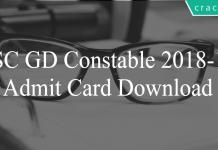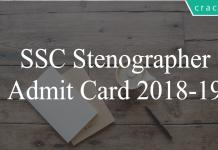Mensuration Questions for SSC CHSL Set-3 PDF
Download SSC CHSL Mensuration questions with answers Set-3 PDF based on previous papers very useful for SSC CHSL Exams. Top-10 Very Important Maths Questions for SSC Exam
Download Mensuration Questions for SSC CHSL Set-3 PDF
Get 200 SSC mocks for just Rs. 249. Enroll here
Take a free mock test for SSC CHSL
Download SSC CHSL Previous Papers
More SSC CHSL Important Questions and Answers PDF
Question 1: The radius of the circumcircle of a right angled triangle is 15 cm and the radius of its inscribed circle is 6 cm. Find the sides of the triangle.
a) 30, 40, 41
b) 18, 24, 30
c) 30, 24, 25
d) 24, 36, 20
Question 2: ABCD is a rhombus. AB is produced to F and BA is produced to E such that AB = AE = BF. Then :
a) ED > CF
b) ED ⊥ CF
c) $ED^{2}+CF^{2}=EF^{2}$
d) ED ║ CF
Question 3: Two circles of same radius 5 cm, intersect each other at A and B. If AB = 8 cm, then the distance between the centres is :
a) 6 cm
b) 8 cm
c) 10 cm
d) 4 cm
Question 4: C and C are two concentric circles with centres at 0. Their radii are 12 cm. and 3 cm. respectively. B and C are the points of contact of two tangents drawn to C2 from a point A lying on the circle C1. Then the area of the quadrilateral ABOC is
a) $\frac{9\sqrt{15}}{2}$ sq.cm
b) $12\sqrt{15}$ sq.cm
c) $9\sqrt{15}$ sq.cm
d) $6\sqrt{15}$ sq.cm
Question 5: If a metallic cone of radius 30 cm and height 45 cm is melted and recast into metallic spheres of radius 5 cm, find the number of spheres.
a) 81
b) 41
c) 80
d) 40
SSC CHSL Study Material (FREE Tests)
Question 6: A cyclic quadrilateral ABCD is such that AB = BC, AD = DC, AC ⊥ BD, ∠CAD = θ. Then the angle ∠ABC =
a) $\theta$
b) $\frac{\theta}{2}$
c) $2\theta$
d) $3\theta$
Question 7: A rectangular tin sheet is 12 cm long and 5 cm broad. It is rolled along its length to form a cylinder by making the opposite edges Just to touch each other. Then the volume of the cylinder is
a) $\frac{60}{\pi}$ $cm^{3}$
b) $\frac{180}{\pi}$ $cm^{3}$
c) $\frac{120}{\pi}$ $cm^{3}$
d) $\frac{100}{\pi}$ $cm^{3}$
Question 8: On decreasing each side of an equilateral triangle by 2 cm, there is a decrease of 4√3 cm 2 in its area. The length of each side of the triangle is
a) 8 cm
b) 3 cm
c) 5 cm
d) 6 cm
Question 9: The base of a right prism is a quadrilateral ABCD. Given that AB = 9 cm, BC = 14 cm, CD = 13 cm, DA = 12 cm and ΔDAB = 90°. If the volume of the prism be 2070 cm3, then the area of the lateral surface is
a) 720 cm2
b) 810 cm2
c) 1260 cm2
d) 2070 cm2
Question 10: If the altitude of an equilateral triangle is 12√3 cm, then its area would be :
a) $12 cm^{2}$
b) $144\sqrt{3} cm^{2}$
c) $72 cm^{2}$
d) $36 \sqrt{3} cm^{2}$
Answers & Solutions:
1) Answer (B)
Circumradius = 15 cm and inradius = 6 cm
Let sides be a,b,c
Since, it’s a right triangle, => Circumradius lies on the mid point of hypotenuse
=> length of hypotenuse(c) = 15*2 = 30 cm
The sum of the other two sides of a right triangle is equal to twice the sum of inradius and circumradius.
=> $(a+b) = 2(15+6)$
=> a+b = 42 ———-Eqn(1)
Now, sum of all sides = 42+30 = 72 cm
Product of the two sides(other than hypotenuse) is equal to the product of inradius and sum of all three sides.
=> ab = 6 * 72
=> ab = 432 ———Eqn(2)
From eqn(1) and (2)
=> a = 18 or b = 24 (or vice versa)
=> Sides are = 18,24,30
2) Answer (B)
ABCD is a rhombus and AB = AE = BF
=> AD = AE and BC = BF
=> $\angle$AED = $\angle$ADE and $\angle$BCF = $\angle$BFC
Let $\angle$DAB = $2\theta$ and $\angle$ABC = $2\alpha$
Using exterior angle property, we get :
=> $\angle$AED = ADE = $\theta$
and $\angle$BCF = $\angle$BFC = $\alpha$
Also, in ABCD
=> $\angle$DAB + $\angle$ABC = 180
=> $2\theta + 2\alpha = 90$
=> $\theta + \alpha = 90$
Now, in $\triangle$GEF
=> $\angle G$ + $\theta + \alpha$ = 180
=> $\angle G$ = 180 – 90 = 90
=> $ED \perp CF$
3) Answer (A)
AB is chord to each of the circle and AB = 8 cm
Radius of each circle = 5 cm
A line drawn from the centre of the circle perpendicular to the chord bisects it in two parts.
=> AC = 8/2 = 4 cm
Now, in $\triangle$ OAC
=> $OC = \sqrt{(OA)^2 – (AC)^2}$
=> $OC = \sqrt{25-16} = \sqrt{9}$
=> OC = 3 cm
=> OO’ = 2*3 = 6 cm
4) Answer (C)

AB = AC = tangents from the same point
OB = OC = 3 and OA = 12
$\angle$ABO = 90
=> AB = $\sqrt{12^2 – 3^2} = 3\sqrt{15}$
Now, area of $\triangle$OAB = $\frac{1}{2}$ OB * AB
= $\frac{1}{2} * 3 * 3\sqrt{15} = \frac{9\sqrt{15}}{2}$
$\therefore$ area of OABC = $9\sqrt{15}$ sq. cm
5) Answer (A)
Volume of metallic cone = $\frac{1}{3} \pi r^2 h$
= $\frac{1}{3} \pi * 30^2 * 45 = 13500 \pi cm^3$
Volume of sphere = $\frac{4}{3} \pi R^3$
= $\frac{4}{3} \pi * 5^3 = \frac{500 \pi}{3} cm^3$
=> Required no. of spheres = $\frac{13500 \pi}{\frac{500 \pi}{3}}$
= 81
6) Answer (C)
AB = BC and AD = DC , $\angle CAD = \theta$
In isosceles $\triangle$ADC
=> $\angle$CAD + $\angle$ACD + $\angle$CDA = 180
=> $2\theta$ + $\angle$CDA = 180
=> $\angle$CDA = 180 – $2\theta$
Sum of opposite angles in a cyclic quadrilateral = 180
=> $\angle$CDA + $\angle$ABC = 180
=> $\angle$ABC + 180 – $2\theta$ = 180
=> $\angle$ABC = $2\theta$
7) Answer (B)

From the above figure circumference of cylinder= 12cm
So 2πR= 12
R= $\frac{12}{2\pi}$
Volume of cylinder= π$(R)^{2}$h
where h and R are height and radius
So volume, V= π$(\frac{12}{2\pi})^{2}\times5$
V=$\frac{180}{\pi}$ $cm^{3}$
8) Answer (C)
Area of an equilateral triangle= $(\frac{\sqrt3}{4})\times(a)^{2}$
where a is side.
When a reduced to (a-2)
Area difference = 4${\sqrt3}$
$(\frac{\sqrt3}{4})$($(a)^{2}-(a-2)^{2})$= 4${\sqrt3}$
4a-4=16
a=5 (C)
9) Answer (A)
In right $\triangle$DAB, using Pythagoras theorem,
=> $BD = \sqrt{(AD)^2 + (AB)^2}$
=> $BD = \sqrt{12^2 + 9^2} = \sqrt{225}$
=> $BD = 15 cm$
Now, area of $\triangle$DAB = $\frac{1}{2} * 9 * 12 = 54 cm^2$
Area of $\triangle$BCD = $\sqrt{s(s-a)(s-b)(s-c)}$
where, $s = \frac{a+b+c}{2}$
=> Area of $\triangle$BCD = $\sqrt{21 * 6 * 7 * 8} = 84 cm^2$
=> Area of quad ABCD = area of $\triangle$DAB + area of $\triangle$BCD
= 54+84 = $138 cm^2$
Volume of prism = base area * height
=> 2070 = 138 * height
=> height = 15 cm
Lateral surface area of prism = perimeter of base * height
= (12 + 9 + 14 + 13) * 15 = 48 * 15
= 720 $cm^2$
10) Answer (B)
Let each side of the equilateral triangle be $a$
The altitude of an equilateral triangle bisects the opposite side.
=> $(\frac{a}{2})^2 + (12\sqrt{3})^2 = a^2$
=> $a^2 – \frac{a^2}{4} = 432$
=> $a^2 = \frac{1728}{3}$
Area of equilateral triangle = $\frac{\sqrt{3}}{4} * a^2$
= $\frac{\sqrt{3}}{4} * \frac{1728}{3}$
= $144\sqrt{3}$
DOWNLOAD APP TO ACESSES DIRECTLY ON MOBILE
We hope this Mensuration questions of set-3 pdf for SSC CHSL Exam preparation is so helpful to you.









